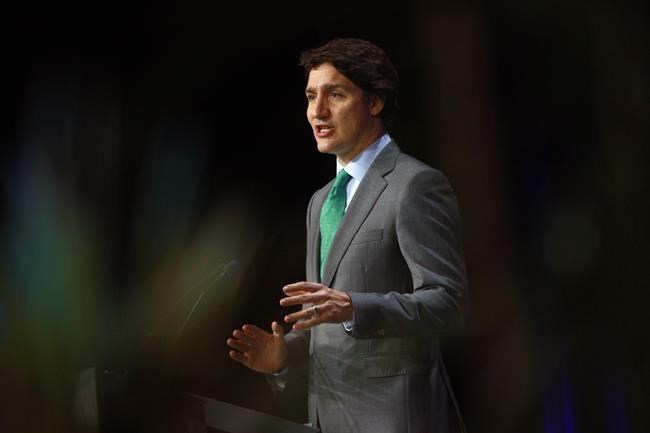CALGARY — A forthcoming federal tax credit for carbon capture and storage is spurring debate between those who say it will help Canada achieve its emissions reduction goals, and those who view it as a thinly veiled subsidy for the oil and gas industry.
Ottawa is expected to unveil its promised carbon capture investment tax credit in next week's federal budget. Though details have not yet been made available, the federal government's emissions reduction plan released Tuesday stated that advancing carbon capture and storage projects features in the mix of "every credible path" to achieving net zero emissions by 2050, including scenarios laid out by the United Nations and the International Energy Agency.
"We shouldn't see this as a silver bullet. It shouldn't be the beginning of our climate change strategy," said Environment Minister Steven Guilbeault in an interview March 27. "But (carbon capture) is going to be one component of many, and one of the tools in our tool box."
Carbon capture and storage (CCS) is a technology that captures greenhouse gas emissions from industrial sources and stores them deep in the ground to prevent them from being released into the atmosphere.
The technology is expensive and has been slow to scale up, in spite of having been around for decades. There are only a small handful of CCS projects currently up and running in Canada, but many proposed projects, including ones by Enbridge Inc., ATCO Ltd., TC Energy, Capital Power, and Pembina Pipeline Corp.
In addition, the Oil Sands Pathways to Net Zero initiative — an alliance of Canadian Natural Resources Ltd., Cenovus Energy Inc., ConocoPhillips, Imperial Oil Ltd., MEG Energy Corp., and Suncor Energy Inc — has proposed a major carbon capture and storage transportation line that would capture CO2 from oilsands facilities and transport it to a storage facility near Cold Lake, Alta.
That project alone could deliver about 10 million tonnes of emissions reductions and could be up and running by the end of the decade, said Mark Cameron, a senior adviser for the oilsands net zero group who works for MEG Energy.
But he said companies need the help of a tax credit to make the project economically viable.
"We’re competing for international capital for these projects," Cameron said. "And jurisdictions like the U.S., like Netherlands, like Norway, have very, very generous financial terms for carbon capture and storage."
Environmental think tank the Pembina Institute says capturing and storing CO2 from oilsands facilities, refineries and gas plants could reduce Canada's emissions by 15 million tonnes by 2030.
The emissions reduction plan tabled by the federal government Tuesday envisions total emissions from the oil and gas sector — including production, refining and transportation via pipelines — falling to 110 million tonnes by 2030, down from 191 million tonnes in 2019.Carbon capture is identified as one of the tools to get there, along with methane reduction and other efforts.
"There is a significant role for carbon capture in decarbonizing the oil and gas industry," said Simon Dyer, the Pembina Institute's deputy executive director. "We don’t know any details about the investment tax credit yet. But we don’t oppose those sorts of investments to sort of kickstart that industry."
However, some environmental organizations are calling on the Trudeau government to scrap its pledged tax credit, saying funding carbon capture and storage is another way of subsidizing fossil fuel production.
"I understand the government’s under a lot of pressure from industry, especially oil and gas, who continue to hold out hope that there’s some kind of tech solution that doesn’t involve reducing the amount of oil and gas that we extract," said Sven Biggs, of Stand.Earth. "But so far the science just doesn’t back that point of view up."
Biggs said his organization would rather see federal money be put toward advancing renewable energy technology and helping to transition oil and gas workers in affected communities, rather than offering a tax credit to oil companies that are currently enjoying record profits due to high commodity prices.
"Speeding up the electrification of things, like our truck and heavy duty vehicle fleet, would do more to both reduce emissions and reduce our dependency on oil and gas in the long run," he said.
Sara Hastings-Simon, an energy and climate policy expert at the University of Calgary's School of Public Policy, said that carbon capture and storage technology could potentially be an "interim" solution that helps to serve as a bridge during the clean energy transition. But she said when it comes to reducing emissions from the fossil fuel sector, carbon pricing is potentially far more powerful than offering tax credits to individual technologies.
"(Carbon capture) addresses emissions from large-scale single point sources, but it doesn’t address emissions from transportation," she said. "And the dominant use of oil is for transportation.”
If the federal government does help to fund carbon capture projects through the use of a tax credit, Hastings-Simon said the public should get to share in any future carbon emission credits that might come from the deployment of the technology.
“If companies are given a 50 per cent contribution from the general public for the cost of those emissions reductions, then they should own a significant portion of that environmental attribute, that future emission reduction," she said.
This report by The Canadian Press was first published March 30, 2022.
— With files from Mia Rabson in Ottawa
Amanda Stephenson, The Canadian Press



